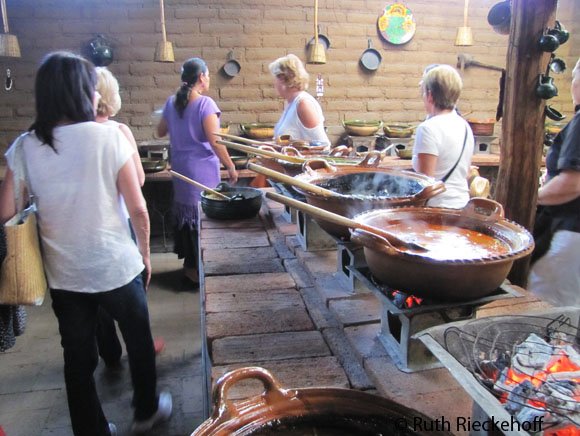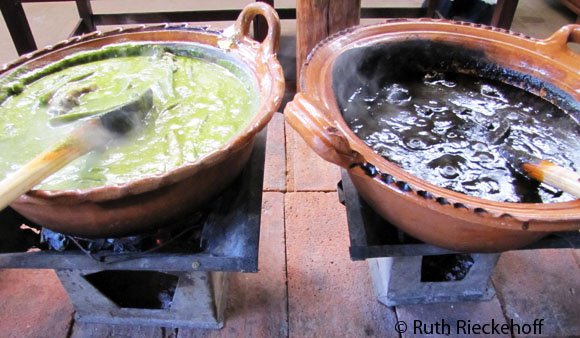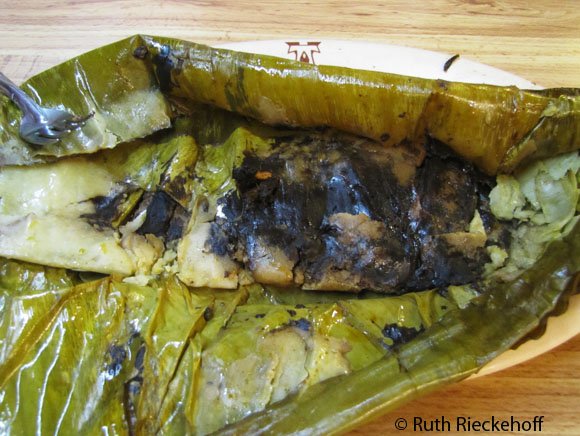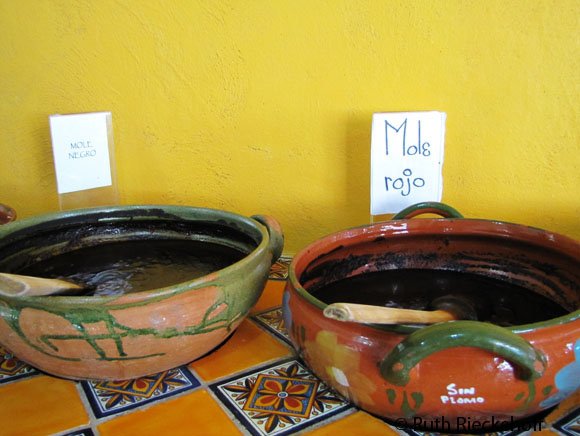Oaxaca is well-known for its delicious mole. This article discussed the different types of moles, how to eat them, and where to buy them.
In an effort to fill my mouth with the delicious flavor of the renowned black mole, I visited an Oaxacan restaurant located in Koreatown (Los Angeles). I ordered an “enmoladas” plate after perusing through the many interesting options on the menu.
A plate of layers was served a few minutes later: three folded tortillas, thick mole sauce, a slice of beef, red onions and a little bit of queso fresco. I rushed to try the mole first.
It is sad to say this but the mole did not meet my expectations. Two flavors were overpowering the sauce: the bitterness of burnt chiles and a sweetness derived from too much sugar or chocolate.
I moved the tortillas drenched in mole to one side and tried to cut the meat while avoiding contact with the sauce. I couldn’t believe I battled traffic and paid a high price to have a taste of something that is supposed to be heavenly good but it wasn’t. That day I said: “I don’t want to try mole again.”
Ohh, how foolish I was that day (I am even ashamed oh what I said). I know very well that all the hype in Los Angeles about “Authentic Mexican Food” dissipates faster than the morning fog. If they can’t do a good taco, how they are supposed to get right a dish that is 20 times more complicated?
The Seven Moles of Oaxaca
When I visited Oaxaca, I have to admit I was scared to try mole after the upsetting experience.
On my first full day in Oaxaca City, we took a break from sightseeing by stopping at a hacienda to have lunch. The options were mouthwatering. I couldn’t decide among a selection of molotes, cheese and epazote empanadas, corn and rice fritters, barbacoa, chicken in peanut sauce, grilled meat, chorizo, soups, salads and more.
But even on a place full of delectable options and enticing aromas, mole was king. Seven clay pots with bubbling sauces were proudly presented by the personnel. When I arrived, the manager directed me here while describing the options and flavors.
Oaxaca is known as the “land of the seven moles.” There seems to be discrepancies on which are the “seven” moles since there are actually more than 7 varieties.
In the hacienda I visited, they had the following:
- Negro (black)
- Rojo (red)
- Amarillo (yellow)
- Green (green)
- Almendrado (the one containing more almonds)
- Pipian (based on pumpkin seeds)
- Chichillo (starts with beef stock, a variety that is slowly disappearing)
Others consider the “Coloradito” (another version of red) one of the seven moles (instead of the pipian).
My First Real Mole Experience
After eating some empanadas and a small tlayuda, I moved on to the mole section. I put a small ball of rice on the middle of the plate an extended it since I didn’t want my different varieties of moles to mix. I tried four first. Then, I went back for the remaining three. Which one I tried first? Well, the black one of course.
This time I entered in a state of blissfulness since the sauce was absolutely delicious. The balance was perfect. There were hints of bitterness, sweetness and spiciness but one flavor wasn’t overpowering the other. You weren’t able to tell what was on the sauce. I believe that is the secret of great mole, turning 30 ingredients into something that tastes unique.
I tasted all the moles and my favorite is the negro closely followed by the coloradito and the almendrado. I can have the sauce alone with a pile of tortillas.
Repeating the Experience
After that first experience, I had mole again four or five times. It was amazing every single time. Each place has its own recipe or gives it a different twist. However, the end result is very addictive. You feel like licking every single drop. This fact reaffirms the supreme ability of Oaxacan cooks. I understand why this is one of the most celebrated cuisines in the world.
How to Eat Mole
Mole is usually served over chicken, turkey or beef and accompanied with a side of rice. It can also be served over fried tortillas, cheese stuffed tortillas (enchilada style) or as a tamale filling.
Bringing Mole Home
I couldn’t leave Oaxaca without stopping at the Mercado Benito Juarez to buy various kilos of mole for my friends and family (and for myself).
I am sure you are going to love mole. Here are some tips for buying at the market:
- Use the opportunity to get authentic mole at a fraction of the price you will pay in the US and other countries. For example, I was able to get half kilo (more than a pound) for $4. The other day, I saw a pound selling for $8 in Los Angeles (and I am sure it is not the same quality).
- Check prices in different stalls before buying.
- Ask if you can have a discount for buying many bags (or in big quantities).
- Some places will let you taste before buying.
- Wrap your paste with extra plastic bags. The oil in the paste tends to leak and it can cause a mess on your suitcase.
- It is easy to prepare the mole once you have the paste. You only have to mix the paste with stock (you can add blended tomatoes and tomatillos) Ask the seller how he or she would prepare it.
- Only negro and colorado moles are available on paste form.
Mole Facts
- Mole is a generic term used to describe a number of sauces. They range from dark and thick to soup-like to bright.
- The two states best known for moles are Puebla and Oaxaca.
- 60% of the mole eaten in the Mexico comes from San Pedro Atocpan near Mexico City.
- Mole poblano is considered the national dish of Mexico. The mole from Puebla is very different from the Oaxacan moles.
- The mole negro is prepared from about 30 ingredients.
- Even though Oaxaca is known for its “seven moles,” there are many more varieties since the state is big and has a diverse topography.
- Ninety-nine percent of Mexicans have tried at least one type of mole.
Have you tried the real, lip smacking mole? Let me know in the comments section below.











James says
Mole is an absolutely scrumptious and unique culinary delight from Oaxaca that will transport your taste buds to a whole new level of deliciousness!